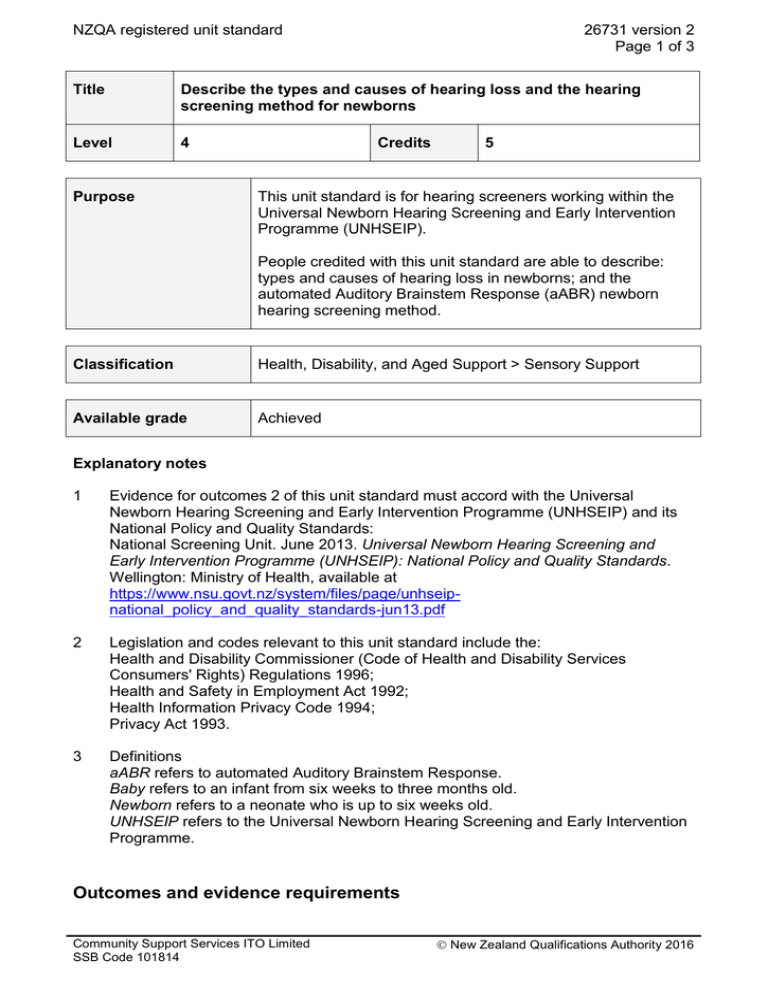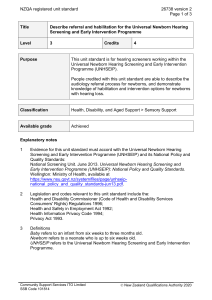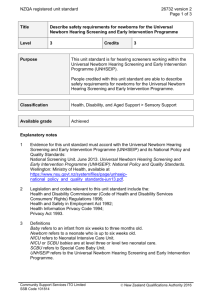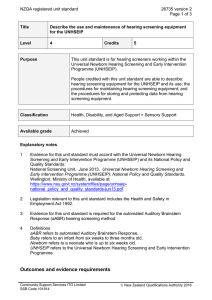NZQA registered unit standard 26731 version 2 Page 1 of 3
advertisement

NZQA registered unit standard 26731 version 2 Page 1 of 3 Title Describe the types and causes of hearing loss and the hearing screening method for newborns Level 4 Purpose Credits 5 This unit standard is for hearing screeners working within the Universal Newborn Hearing Screening and Early Intervention Programme (UNHSEIP). People credited with this unit standard are able to describe: types and causes of hearing loss in newborns; and the automated Auditory Brainstem Response (aABR) newborn hearing screening method. Classification Health, Disability, and Aged Support > Sensory Support Available grade Achieved Explanatory notes 1 Evidence for outcomes 2 of this unit standard must accord with the Universal Newborn Hearing Screening and Early Intervention Programme (UNHSEIP) and its National Policy and Quality Standards: National Screening Unit. June 2013. Universal Newborn Hearing Screening and Early Intervention Programme (UNHSEIP): National Policy and Quality Standards. Wellington: Ministry of Health, available at https://www.nsu.govt.nz/system/files/page/unhseipnational_policy_and_quality_standards-jun13.pdf 2 Legislation and codes relevant to this unit standard include the: Health and Disability Commissioner (Code of Health and Disability Services Consumers' Rights) Regulations 1996; Health and Safety in Employment Act 1992; Health Information Privacy Code 1994; Privacy Act 1993. 3 Definitions aABR refers to automated Auditory Brainstem Response. Baby refers to an infant from six weeks to three months old. Newborn refers to a neonate who is up to six weeks old. UNHSEIP refers to the Universal Newborn Hearing Screening and Early Intervention Programme. Outcomes and evidence requirements Community Support Services ITO Limited SSB Code 101814 New Zealand Qualifications Authority 2016 NZQA registered unit standard 26731 version 2 Page 2 of 3 Outcome 1 Describe types and causes of hearing loss in newborns. Evidence requirements 1.1 Types of hearing loss in newborns are described in terms of the parts of the ear that are affected. Range 1.2 conductive, sensorineural, mixed, auditory neuropathy. Types of hearing loss in newborns are described in terms of possible causes. Range 1.3 evidence is required for one congenital cause, one progressive cause, one acquired cause. Bilateral hearing loss and unilateral hearing loss are described in terms of their differences. Outcome 2 Describe the aABR newborn hearing screening method. Evidence requirements 2.1 The aABR screening method is described in terms of what it measures, and its benefits and limitations for newborn hearing screening. 2.2 Reasons why auditory brainstem responses may not be recorded during aABR screening are described in accordance with the National Policy and Quality Standards. Range 2.3 evidence is required for six reasons. Methods for optimising screening conditions to obtain the best results are described in accordance with the National Policy and Quality Standards. Range evidence is required for six methods. Planned review date 31 December 2016 Status information and last date for assessment for superseded versions Process Version Date Last Date for Assessment Registration 1 22 October 2010 31 December 2016 Rollover and Revision 2 17 September 2015 N/A Community Support Services ITO Limited SSB Code 101814 New Zealand Qualifications Authority 2016 NZQA registered unit standard 26731 version 2 Page 3 of 3 Consent and Moderation Requirements (CMR) reference 0024 This CMR can be accessed at http://www.nzqa.govt.nz/framework/search/index.do. Please note Providers must be granted consent to assess against standards (accredited) by NZQA before they can report credits from assessment against unit standards or deliver courses of study leading to that assessment. Industry Training Organisations must be granted consent to assess against standards by NZQA before they can register credits from assessment against unit standards. Providers and Industry Training Organisations, which have been granted consent and which are assessing against unit standards must engage with the moderation system that applies to those standards. Requirements for consent to assess and an outline of the moderation system that applies to this standard are outlined in the CMR. The CMR also includes useful information about special requirements for organisations wishing to develop education and training programmes, such as minimum qualifications for tutors and assessors, and special resource requirements. Comments on this unit standard Please contact the Community Support Services ITO Limited info@careerforce.org.nz if you wish to suggest changes to the content of this unit standard. Community Support Services ITO Limited SSB Code 101814 New Zealand Qualifications Authority 2016


